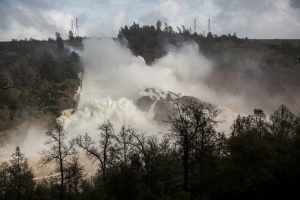
By Alister Doyle
OSLO (Reuters) – California will suffer more volatile weather this century with a “whiplash” from drought to rain and mounting risks a repeat of the devastating “Great Flood” of 1862, scientists said on Monday.
Climate change, driven by man-made greenhouse gas emissions, would drive more extreme shifts between hot and dry summers and wet winters in the most populous U.S. state, they wrote in the journal Nature Climate Change.
Global warming is making California and other regions with similar Mediterranean-style climates, from southern Europe to parts of Australia, drier and warmer in summer, said lead author Daniel Swain of the University of California, Los Angeles.
In California in winter “an opposing trend toward a strong Pacific jet stream is projected to locally enhance precipitation during the core months of the ‘rainy season’,” he told Reuters.
“Natural precipitation variability in this region is already large, and projected future whiplash increases would amplify existing swings between dry and wet years,” the authors wrote.
They projected “a 25 percent to 100 percent increase in extreme dry-to-wet precipitation events” this century.
California had its worst drought in recorded history from 2010–2016, followed by severe rains and flooding that culminated with evacuation orders for almost 200,000 residents as a precaution near the Oroville Dam last year.
The study said that major urban centers, including San Francisco and Los Angeles, were “more likely than not” to suffer a freak series of storms by 2060 similar to ones in 1861-62 that led to the “Great Flood”.
The storms swamped the Sacramento and San Joaquin valleys, flooding an area 300 miles (500 km) long and 20 miles wide. Storms washed away bridges, inundated mines and wrecked farms.

FILE PHOTO: 65,000 cfs of water flow through a damaged spillway on the Oroville Dam in Oroville, California, U.S., February 10, 2017. REUTERS/Max Whittaker/File Photo
A repeat “would probably lead to considerable loss of life and economic damages approaching a trillion dollars”, the study said.
As part of planning, Swain said the state should expand use of floodplains that can be deliberately flooded to soak up rains, such as the Yolo Bypass which protects the city of Sacramento.
The study assumes, however, that global greenhouse gas emissions will keep rising, at odds with the goals of the 2015 Paris Agreement under which almost 200 nations agreed to cut emissions to net zero between 2050 and 2100.
“Such a future can be partially, but not completely, avoided” if the world takes tougher action, Swain said. He noted that existing government pledges to limit warming fall well short of the Paris goals.
U.S. President Donald Trump, who doubts mainstream findings that greenhouse gas emissions are the main cause of warming, plans to quit the deal, saying he wants to promote the U.S. fossil fuel industry.
(Reporting by Alister Doyle; Editing by Alison Williams)

